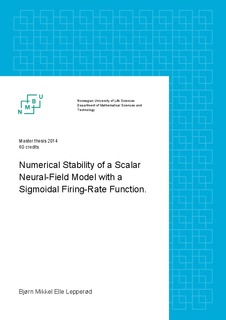| dc.contributor.author | Lepperød, Bjørn Mikkel Elle | |
| dc.date.accessioned | 2014-08-22T10:41:25Z | |
| dc.date.available | 2014-08-22T10:41:25Z | |
| dc.date.copyright | 2014 | |
| dc.date.issued | 2014-08-22 | |
| dc.identifier.uri | http://hdl.handle.net/11250/217901 | |
| dc.description.abstract | Many neural-field models in neuroscience mimic the all or nothing behavior of a neuron firing an action potential. The neural-field model considered in this study is a spatio-temporal scalar neural-field (NFL) model given as a partial integro differential equation (PIDE). The model yields temporal changes in probability of neural activity in a given spatial point. A point has a high probability of activity when the solution of the NFL model is above a firing threshold. The sensitivity to change in probability is measured by a steepness parameter β.
Various numerical methods have been employed on this (and similar) type(s) of neural-field model(s) without analysis of numerical convergence, stability and consistency. The aim of this thesis is to obtain a better understanding of the NFL model's well-posedness theory and its biophysical background. Further to analyze the numerical convergence theory of the NFL model approximated by simple explicit numerical methods.
To obtain a comprehensive overview of the NFL model, we review its biophysical derivation and discuss two proposed formalisms with respect to numerical analysis and well-posedness theory. Further, we review a global well-posedness proof of the Cauchy formulated NFL model in a Banach space of continuous functions. We further perform an analysis of the numerical error obtained in the forward Euler and Heun's second order Runge--Kutta (RK2) method. Finally we illustrate numerical behavior by experiments applying the forward Euler and an explicit RK4 method.
Presented analytical work indicate stiffness (a necessity for a significantly small temporal stepping length) in the NFL model when approximated by the forward Euler method. This is due to a dependency between the numerical error and the steepness parameter β. The RK2 truncation error contains β^2, indicating that β^N is contained in the RKN truncation error. Thus, by increasing the order of the RK method, we predict no remedy with respect to stiffness.
Performed numerical experiments on a simplified version of the NFL model demonstrate stiffness in the proximity of the firing threshold for moderately sized steepness parameters β. We further demonstrate a divergence between the exact and the approximated solution of a slightly less simplified version of the NFL model. This happens when the approximated solution is shifted from one basin of attraction to another, giving rise to a large numerical error. In addition, we observe spurious solutions in the form of false oscillations and an erroneous fixed point. Thus indicating a possibility for numerical solutions of the NFL model to be rather arbitrary when the temporal stepping lengths are not carefully selected.
Presented results indicate serious numerical stability issues in the NFL model. We suggest further evaluation and development of more sophisticated numerical methods for future application of this (and similar) type(s) of neural-field model(s). Finally, we argue the simplicity of the NFL model to be undermined by the complications observed in numerical approximations. We propose focus to be directed towards developing more robust field-models with respect to numerical analysis rather than developing more complicated numerical methods. | nb_NO |
| dc.language.iso | eng | nb_NO |
| dc.publisher | Norwegian University of Life Sciences, Ås | |
| dc.subject | Neuro field models | nb_NO |
| dc.subject | Numerical stability | |
| dc.title | Numerical stability of a scalar neural-field model with a sigmoidal firing-rate function | nb_NO |
| dc.title.alternative | Numerisk stabilitet av en skalar nevrofeltmodell med s-formet fyringsratefunksjon | nb_NO |
| dc.type | Master thesis | nb_NO |
| dc.description.localcode | M-MR | |
